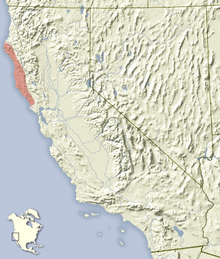Yellow-cheeked chipmunk
| Yellow-cheeked chipmunk | ||||||||||||
|---|---|---|---|---|---|---|---|---|---|---|---|---|
| Systematics | ||||||||||||
|
||||||||||||
| Scientific name | ||||||||||||
| Tamias ochrogenys | ||||||||||||
| ( Merriam , 1897) |
The yellow-cheeked chipmunk ( Tamias ochrogenys , syn .: Neotamias ochrogenys ) is a type of squirrel from the genus of the chipmunk ( Tamias ). It occurs in the coastal area in the north of the American state California .
features
The yellow-cheeked chipmunk reaches an average head-trunk length of about 14.7 to 15.2 centimeters, the tail length is about 10.9 to 11.5 centimeters and the weight is about 70 to 90 grams. As with other species of the genus, the fur is brown and there are several dark back stripes on the back, which are separated by lighter stripes and delimited from the sides of the body. The species differs from other species of the family group around the Townsend chipmunk ( Tamias townsendii ), which also includes the Allen chipmunk ( Tamias senex ) and the Siskiyou chipmunk ( Tamias siskiyou ), in that it has slightly larger body dimensions and a thinner tail , the shape of the penis bone and the communication sounds . It also differs from the Sonoma chipmunk ( Tamias sonomae ) and the Merriam chipmunk ( Tamias merriami ), which occurs south of the Bay of San Francisco , in terms of body size, darker coat color and shorter tail.
distribution
The yellow-cheeked chipmunk occurs in the coastal area in the northwest of the American state California from the Van Duzen River and Eel River to the south of Sonoma County north of Bodega and Freestone .
Way of life
Yellow-cheeked chipmunks live in the northern California coastal areas in the redwood forests shaped by the coast redwood ( Sequoia sempervirens ), including in Redwood National Park . It prefers coniferous forest zones with dense undergrowth , the habitat is limited to a coastal strip up to a maximum of 40 kilometers from the coast and at altitudes of up to 1280 meters. The species is diurnal and primarily ground-living, but can also climb trees and bushes. The animals feed mainly herbivorous of parts of plants, seeds and fruits, added fungi and insects. It lives mainly in the thick undergrowth and bushes and is therefore difficult to find; typical, however, is the low-frequency and two-part call of the animals, which differs from that of related species.
Little data is available on reproduction. The males are able to reproduce from March to June, a pregnant female with four embryos was caught in mid-March. Based on sound recordings of intermediate calls, it is assumed that matings and hybrids between yellow-cheeked chipmunks and Allen chipmunks ( Tamias senex ) also occur in Humboldt County , California .
About predators has no information when parasites are warble flies (genus Cuterebra ) and the Tierlaus Hoplopleura arboricola documented.
Systematics
The yellow-cheeked chipmunk is classified as an independent species within the genus of chipmunks ( Tamias ), which consists of 25 species. The first scientific description comes from the American naturalist Clinton Hart Merriam from 1897, who described it as Eutamias townsendi ochrogenys based on individuals from the region around Mendocino in Mendocino County , California. Within the chipmunk group, the yellow-cheeked chipmunk is assigned to the subgenus Neotamias , together with most of the other species , which is also discussed as an independent genus. The yellow-cheeked chipmunk is and was partially considered a subspecies of the Townsend chipmunk ( Tamias townsendii ).
Apart from the nominate form, no further subspecies are distinguished within the species .
Status, threat and protection
The yellow-cheeked chipmunk is classified by the International Union for Conservation of Nature and Natural Resources (IUCN) as “not endangered” (Least Concern, LC) despite its limited distribution area of less than 20,000 km 2 . This is justified by the regular occurrence in its area of distribution and the lack of risks that could endanger the existence of the plant.
supporting documents
- ↑ a b c d e f g h i j Richard W. Thorington Jr. , John L. Koprowski, Michael A. Steele: Squirrels of the World. Johns Hopkins University Press, Baltimore MD 2012; Pp. 329-330. ISBN 978-1-4214-0469-1 .
- ↑ a b c Neotamias ochrogenys in the IUCN Red List of Threatened Species 2015.4. Submitted by: AV Linzey, NatureServe (G. Hammerson), 2008. Retrieved June 16, 2016.
- ↑ a b c Tamias (Neotamias) ochrogenys In: Don E. Wilson , DeeAnn M. Reeder (Ed.): Mammal Species of the World. A taxonomic and geographic Reference. 2 volumes. 3. Edition. Johns Hopkins University Press, Baltimore MD 2005, ISBN 0-8018-8221-4 .
- ^ William L. Gannon, Richard B. Forbes, Douglas E. Kain: Tamias ochrogenys. Mammalian Species 445, 1993.
- ↑ Bruce D. Patterson, Ryan W. Norris: Towards a uniform nomenclature for ground squirrels: the status of the Holarctic chipmunks. Mammalia 80 (3), May 2016; Pp. 241-251 doi : 10.1515 / mammalia-2015-0004
literature
- Richard W. Thorington Jr. , John L. Koprowski, Michael A. Steele: Squirrels of the World. Johns Hopkins University Press, Baltimore MD 2012; Pp. 329-330. ISBN 978-1-4214-0469-1
- William L. Gannon, Richard B. Forbes, Douglas E. Kain: Tamias ochrogenys. Mammalian Species 445, 1993.
Web links
- Neotamias ochrogenys inthe IUCN Red List of Threatened Species 2015.4. Submitted by: AV Linzey , NatureServe (G. Hammerson), 2008. Retrieved June 16, 2016.
